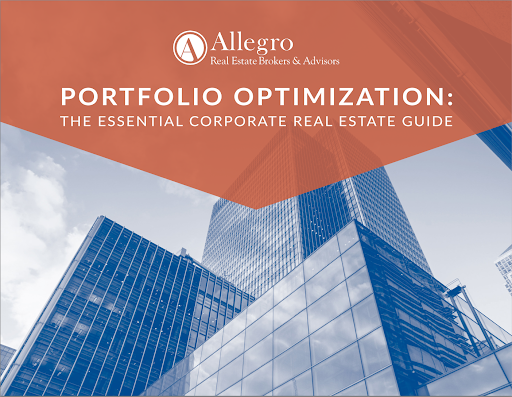Since the COVID-19 pandemic rolled through the U.S., the government stay-at-home orders and steep economic downturn have significantly impacted commercial real estate. With the flick of a switch, we went from a landlord’s to a tenant’s market. With that said, most landlords have not yet fully felt the effect of changes in tenant behavior, such as downsizing, reconfiguring, negotiating new lease language, and in more extreme cases, allowing leases to expire or proactively terminating them altogether.
Today, we are not in a “new normal” – rather, this is a temporary abnormal phase. The “next normal” has not yet presented itself. Lease clauses, space plans, and furniture configurations will evolve. Many companies’ current thoughts about Work-From-Home (“WFH”) becoming a permanent approach may prove to be an overcorrection to this misconception that we are currently in a “new normal” phase. At Allegro, we expect that the pendulum will significantly swing back once we reach the “next normal.” For the time being, Allegro recommends to most of its clients to avoid making major capital investments in reaction to COVID-19-related recommendations during this temporary abnormal phase.
Because Allegro’s practice primarily serves occupants of office and industrial buildings, our experience focuses on issues that have been top priorities for our tenant representation and national/global corporate clients during the COVID-19 era, most of which become a shared challenge within the landlord-tenant relationship.
What We’ve Seen
As soon as the government orders started to ripple across the U.S., many of Allegro’s national clients became hyper-focused on reducing operating expenses and directed Allegro to seek rent relief across their leased portfolios. At that time, we recommended that our clients evaluate other options for relief, before (or at least concurrently with) seeking rent relief from their landlords. The issues we looked at with our clients were as follows:
- Force Majeure Clauses in leases: First, we reviewed these clauses to see if and how pandemic and government shutdowns are addressed. Second, if addressed, we needed to determine if the tenant can receive monetary relief. In nearly all cases, these clauses primarily provide non-monetary remedies and have not been financially helpful to tenants.
- Business Interruption Insurance: We have advised our clients to seek coverage from their insurers for those tenants with business interruption coverage. Nearly all claims have been rejected (for the time being), with insurers indicating that this coverage is intended for cases of physical damage and/or impediments and not business interruption caused by government mandates. Further, the insurance endorsements often include virus/bacteria exclusions.
- Flexibility Rights: We next shifted our focus to opportunities related to remaining lease term, early termination rights, and contraction rights to identify rent relief options within the existing lease agreements. These rights can also be used as leverage to renegotiate lease structures.
- Government Relief Programs: The CARES Act has provided programs, including Payroll Protection Program Loans for small businesses (defined as 500 employees or less), which include loan forgiveness if the funds are utilized for payroll, as amended, over a 24-week period and now allows up to 40% of loan proceeds to be applied to rent, utilities, and mortgage payments. Additionally, the Main Street Lending Program was established to support mid-size companies (defined as 500 to 10,000 employees) through four-year loan terms with principal and interest payments deferred for one year. While many of Allegro’s clients fall into the small and mid-size business categories, our Fortune 1000 corporate clients do not qualify for these loans.
- Rent Relief: Finally, we spent a great deal of April, May, and June negotiating rent abatement, rent deferral, and blend-and-extend transactions. Overall, we have had meaningful success with these negotiations. We found that landlord responses varied greatly based on product type, landlord sophistication, tenant credit, and the landlord’s debt structure and maturity date. We were able to achieve meaningful short-term rent relief with creative solutions that met both landlord and tenant needs, while demonstrating our clients’ previous efforts to seek other means of relief (often including company-wide pay cuts) before or concurrently with seeking assistance from landlords.
What We See Now
From a macro level, in our lease negotiations during this time, we notice a trend of clients’ transactions falling into six different groups:
- Short-term rent relief as described above
- Downsizing (subleases, contraction rights, and early terminations on all or part of the space)
- Blend-and-extend (near-term rent relief in exchange for long-term lease commitments)
- Deals put on hold or declared dead (mostly new projects, but even some fully negotiated transactions)
- Short-term renewals (to maintain flexibility in volatile markets and reevaluate once there is more predictability)
- Business as usual: Moreover, at a micro level, we find our clients, their legal counsel, and ourselves spending more time on clauses that may have previously been subject to less scrutiny:
- Possession Date: Concerns arise over the timing of tenant improvements and the landlord’s delivery of space to the tenant. Although construction activities have qualified as an “essential business operation” in most states, reservations remain over the permitting process due to municipal government furloughs. Beyond that, fears continue about future government orders due to potential future spikes of the pandemic.
- Force Majeure/Business Interruption Insurance: As discussed above, both force majeure clauses and business interruption insurance coverage have failed to provide financial relief during the COVID-19 pandemic. As a result, lease provisions are in the early stages of refinement to better reflect the potential for future pandemics and government stay-at-home orders.
- Flexibility Rights: For decades now, flexibility rights in leases have been important to most of Allegro’s corporate clients. However, especially with the current uncertainty around the pandemic duration and negative economic impact, tenants are focused on greater flexibility through more robust expansion, contraction, renewal, early termination, and assignment/subleasing rights.
- Landlord Obligations: Due to the airborne nature of the pandemic, tenants are placing an increased emphasis on health and safety issues. More attention is being paid to landlords’ property management practices and building rules and regulations, including: frequent cleaning of common areas, diligent maintenance of HVAC filtration and other building systems, building mandates about physical spacing in lobbies and elevator passenger queueing for low-density usage, and communication protocols for confirmed COVID-19 cases. For one of our national corporate clients, Allegro surveyed all landlords across the U.S. to determine which were meeting the tenant’s health and safety protocols.
In general, disruptive periods should be redirected as opportunities to conduct real estate portfolio assessments. Portfolio assessments provide the opportunity to become more strategic and efficient with the aim of determining which assets and practices are adding strategic, operational, and financial value and which aspects need to be adapted, improved, or divested. We are supporting our clients to develop strategies reflective of their current and forecasted business needs, while capitalizing on the currently unique market conditions.
What We Expect to See
As long as COVID-19 exists, office and industrial space use will be impacted by the progressing WFH culture, in addition to social distancing and physical space layout modifications.
Since the stay-at-home orders, many have begun to tout increased employee productivity and efficiency from WFH arrangements. However, when discussing these issues with Allegro’s clients, we are hearing and seeing diverse reviews of WFH on a permanent basis. Further, several surveys and articles are suggesting counterintuitive results, such as younger, tech-savvy employees being more eager for office re-openings than many of their older colleagues. Ultimately, employers should be patient as they sort out how to implement the aforementioned trends and their potential long-term impact on corporate culture, operations, employee attraction/retention, and real estate needs.
Allegro is advising our clients to consider three primary factors before making long-term decisions about the linkage of real estate and WFH arrangements. In our opinion:
- We have been experiencing a unified spirit of “we are all in this together.”
- During sharp economic downturns, employees are highly concerned about keeping their jobs.
- Most employees see a “light at the end of the tunnel,” despite the uncertainty of when it may be reached.
So, when companies decide to close or substantially reduce office space, they are sending a message to their employees:
- We are shutting off the light at the end of the tunnel.
- We are no longer all in this together.
- When the job market improves, some employees may seek new jobs that provide in-person human interaction.
One size does not fit all. For example, what is good for big tech companies does not seem to work for law firms. The successful application of WFH, full-time or part-time, depends on many factors. These include the industry/department, job classifications and the personality types attracted by the same, the significance of creativity and collaboration, and the use of niche machinery and equipment.
Once we reach the “next normal,” we anticipate that many employers will provide more flexibility for WFH than in the past. WFH arrangements may be viewed as a benefit by many employees and may be a positive attraction tool. Even according to research, those with the option versus the requirement to work from home have the highest employee engagement. However, a permanent, full-time WFH policy comes at the cost of several items: corporate culture, collaboration, creativity, and most importantly, feeling like you are a part of something bigger. There will always be a fundamental need for humans to have in-person human interaction to instill a corporate culture, augment creativity from spontaneous collaboration, maintain mental well-being, increase job satisfaction, and ultimately, increase employee retention. The currently abnormal times provide the precise opportunity to create a more flexible work environment. However, companies need to be increasingly thoughtful in how they brainstorm, structure, and execute it.
Finally, the future will be impacted by physical space changes that were made during the pandemic. Though many companies are not investing a significant sum, they are investing in small, targeted initiatives that provide employees with a sense of health safety. This is the first time our generation has experienced a pandemic, so there is a hypersensitivity toward health risks. For instance, there may be a change in the material choices (such as desk surfaces and flooring) that are able to withstand heavy cleaning on a regular basis. Similarly, companies may invest more in air filtration systems that use ultraviolet light for a cleaner result. And, offices may see more sinks, including in reception and common areas.
From a technology standpoint, many offices may adopt the “contactless office” concept, in which the need to press communal buttons is eliminated. This could instead be conducted through: voice-activated technology, such as to control audio and visual equipment; smartphones, such as to send a command to an elevator; or a simple wave, such as to pass through a door.
As previously stated, Allegro recommends to our clients to be patient and to not make long-term capital investments based on short-term conditions.
Michael Cantor, Managing Director & Principal of Allegro Real Estate Brokers & Advisors, spoke on related topics at NAIOP’s “Landlords and Tenants: Changes in the COVID-19 Era” on June 24, 2020. See below to view the presentation and video.
Align Your Real Estate with Your Business Strategy
There’s a lot to think about as you strategize your real estate portfolio in the future. Whether you’re planning out weeks, months, or years ahead of time, the best solution to optimizing your real estate portfolio is to have a trusted partner on your side to advise and help manage your assets.
Download our free guide, Corporate Real Estate Portfolio Strategy: Your Business’ Competitive Advantage, to help you through your asset evaluation today.







